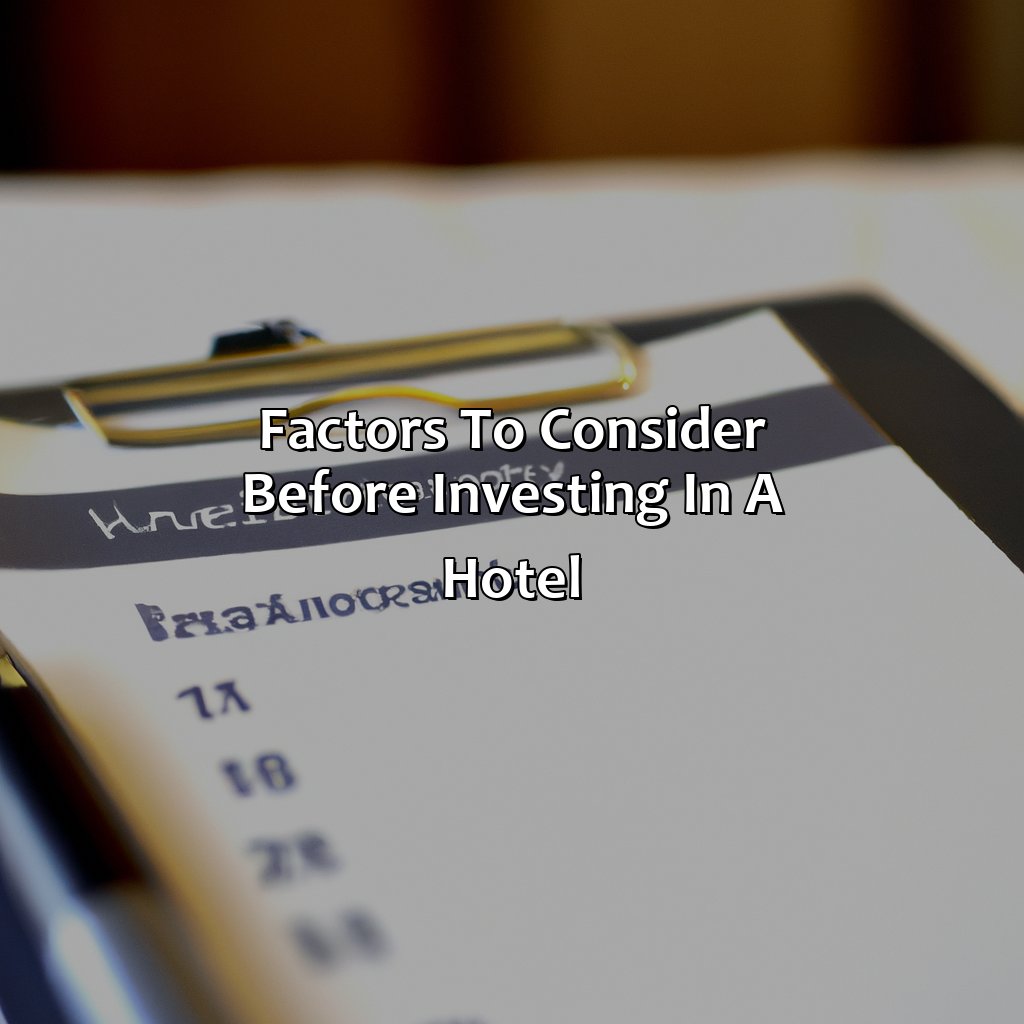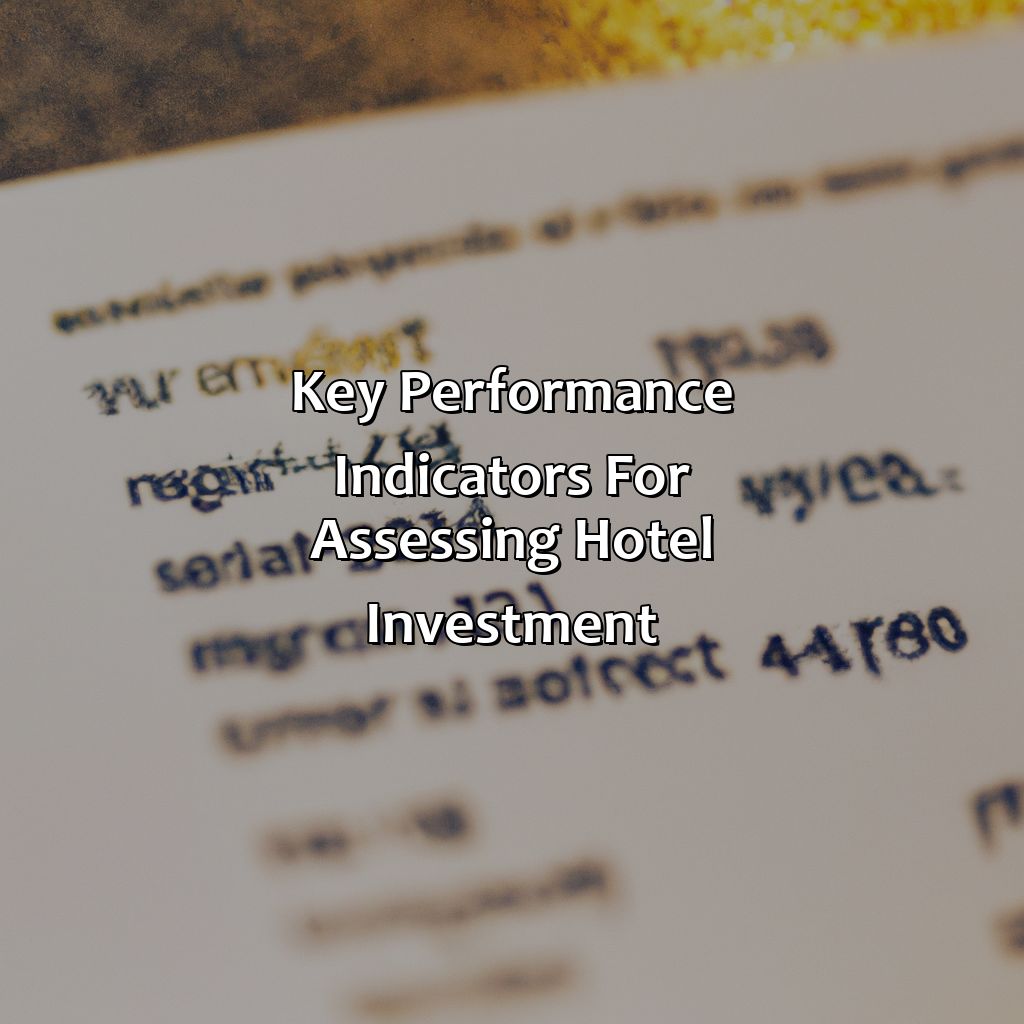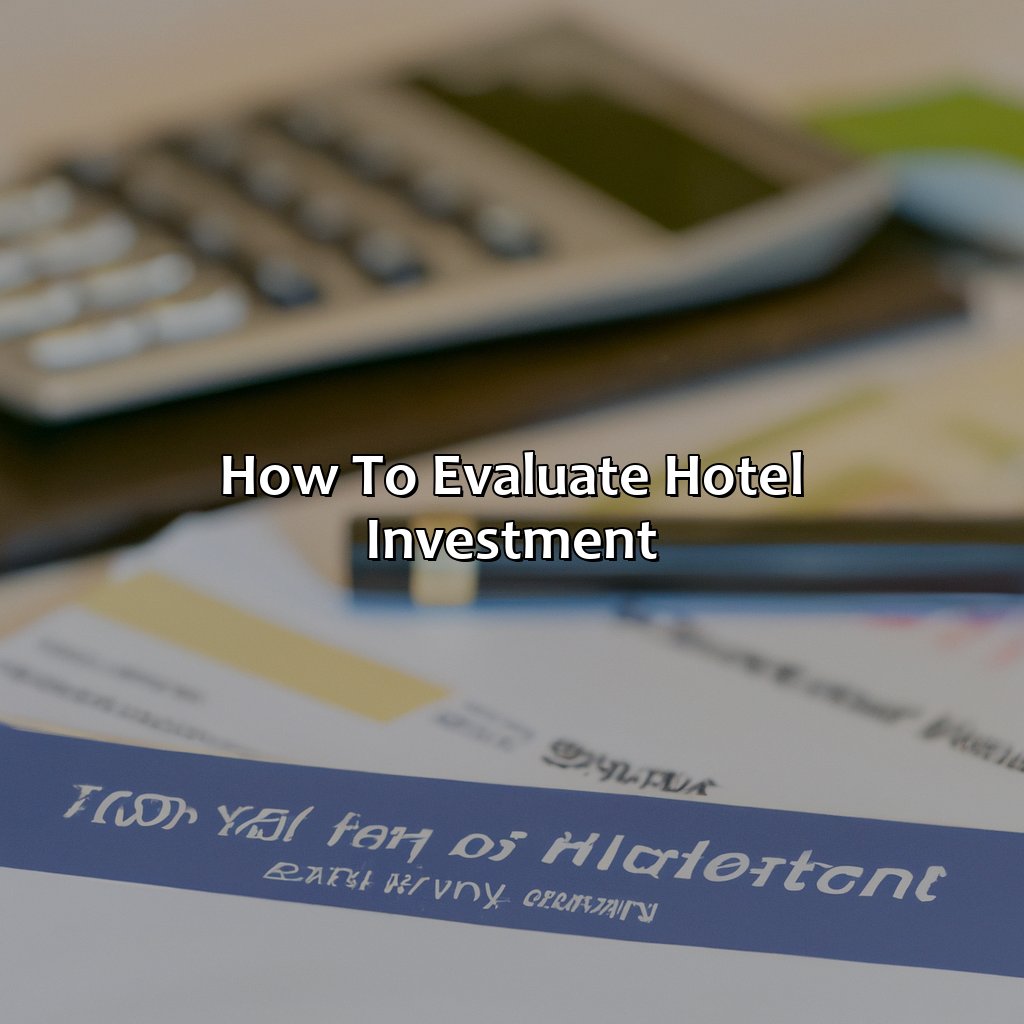How To Evaluate Hotel Investment?
Key Takeaway:
- Before investing in a hotel, it is important to conduct a thorough location and market analysis to ensure the investment aligns with the investor’s goals and objectives. This involves evaluating factors such as population growth, tourism demand, and supply and demand dynamics in the market
- Another important factor to consider is competitive analysis, which involves researching the existing hotels in the area and their offerings, pricing strategies, and occupancy rates to determine the investment’s potential for success.
- Financial analysis is also crucial when evaluating hotel investment. Investors should assess the investment’s potential profitability through evaluating cash flows, expenses, and financing options to determine whether it is financially feasible.
- Key performance indicators to measure hotel investment success include occupancy rate, average daily rate (ADR), revenue per available room (RevPAR), and gross operating profit per available room (GOPPAR). These KPIs allow investors to track the performance of their investment and determine whether it is meeting their financial goals.
Are you considering investing in a hotel but not sure where to start? This article will provide you with steps to evaluate hotel investment and help you make informed decisions. Read on to learn the detailed process for evaluating hotel investments.
Factors to Consider Before Investing in a Hotel
Evaluate key factors when investing in a hotel. Look at the hotel’s:
- Location
- Market analysis
- Competitive analysis
- Financial analysis
All these work together to figure out potential profitability. Also, don’t forget to consider the investment horizon and risk profile.

Image credits: retiregenz.com by Adam Duncun
Location and Market Analysis
When investing in a hotel, it is crucial to evaluate the location and analyze the market to ensure profitability. A thorough understanding of the area’s demographics, tourism trends, transportation access, and competition will help determine the hotel’s potential success.
Considering aspects such as the proximity to tourist attractions or business districts, and accessibility to public transportation are key indicators of how well the hotel could perform. Market analysis should cover demand for rooms in peak seasons and off-peak seasons to predict occupancy rates.
Additionally, evaluating competitors’ strengths and weaknesses can help identify opportunities or threats to the investment project. Local regulations may also impact operations and finances.
An investor once purchased a hotel located near a famous landmark with high foot traffic but didn’t consider its outdated facilities. The lack of modern amenities turned off guests, resulting in declining revenues. Learning from this experience emphasizes how crucial analyzing market trends is when investing in a property.
Before investing in a hotel, make sure you know your competition–they may have beds that are even comfier than yours.
Competitive Analysis
Ascertaining the Competitive Landscape
A comprehensive analysis of the hospitality market is essential to evaluate hotel investments. One such aspect is to examine the competitive landscape…
- A SWOT analysis of competing hotels helps identify market opportunities and threats.
- An examination of marketing strategies used by similar hotels can help in building an effective strategy for the hotel under consideration.
- Determining the target customer base of competing hotels helps to understand what elements should be prioritized while designing or renovating a property.
- Analyzing pricing strategies utilized by rival hotels enables the identification of appropriate market positioning and pricing decisions for a new establishment.
- Understanding the unique selling propositions, amenities, and experiences provided by opposing entities provides insights that may not have been considered otherwise.
Focusing on unique and informative details about competitions can shed light on areas requiring attention while evaluating potential investments.
Pro Tip: Keep a close watch on competitive entities’ activities to stay informed about changes in their strategies, promotions, or aesthetics developments.
Before investing in a hotel, make sure you do a financial analysis – otherwise you might end up with a roach motel instead of a five-star resort.
Financial Analysis
Assessing the Fiscal Feasibility
Providing a thorough analysis of the financial aspects before investing in a hotel is crucial. This includes evaluating the profitability, cash flow, and return on investment (ROI). Considering these factors ensures secure and substantial gains over time.
The following table shows the financial analysis and data required:
| Financial Analysis | Data Required |
|---|---|
| Profitability | Revenue, operating expenses |
| Cash Flow | Net income, depreciation, loan payments |
| Return On Investment (ROI) | Initial investment, future earnings |
In addition to financial viability, one must consider other essential factors like location, competition, market demand and trends before arriving at an informed decision. These detailed analyses collectively guarantee profit margins and long-term sustainability.
According to hotels.com survey(2021), around 45% of investors recognized lack of research as the biggest mistake made when entering this industry.
Remember, investing in a hotel is like taking a long-term relationship to the next level – you better make sure you’re ready for the commitment and potential heartache.
Investment Horizon and Risk Profile
In evaluating hotel investment, it is essential to explore your time horizon and risk appetite. This means understanding how long you intend to hold assets and the degree of risk you are ready to withstand. The longer the investment horizon, the higher the risk that can be taken in anticipation of higher returns.
Considering possible future events like economic downturns and competition level aids in assessing your Risk Profile. It’s important to make informed decisions based on historical data and trends within the industry while keeping an eye on changes.
Location analysis, brand strength, market share, cash flow, and management team should be considered for a successful investment outcome. All these factors play significant roles in determining hotel performance.
A prominent story is that of Hilton Hotels owning over 4000 branded hotels under 14 different brands worldwide with a net income of over $800mn as at Dec’20. Its success story indicates strong branding, scalability and an excellent management team capable of driving business growth.
Assessing a hotel investment without KPIs is like trying to drive blindfolded, except with more financial risk involved.
Key Performance Indicators for Assessing Hotel Investment
To assess hotel investments efficiently, you need to concentrate on the correct indicators. Here, you’ll discover the critical performance indicators which are vital for gauging the profitability of a hotel investment. Analyzing occupancy rate, average daily rate (ADR), revenue per available room (RevPAR), and gross operating profit per available room (GOPPAR) will provide you with insight into the hotel’s fiscal performance. Thus, you can make well-educated investment choices.

Image credits: retiregenz.com by James Arnold
Occupancy Rate
The percentage of guest rooms occupied during a specific time frame is an essential metric for determining a hotel’s success, also known as the Room Occupancy Rate. This KPI indicates how well the property attracts and retains guests. It is calculated by dividing the number of occupied rooms by the total available rooms on any given day or period.
A high room occupancy rate suggests that the property is meeting customer expectations and beating out competitors in attracting visitors to their destination. However, maintaining high room occupancy rates can be challenging, especially when demand for accommodations fluctuates due to seasonality and travel trends.
One way to overcome this challenge is by understanding historical data patterns and adjusting operations accordingly to maximize room occupancy rates. For example, rearranging staff schedules or lowering prices during low season periods could increase demand from price-sensitive visitors.
Pro Tip: Use revenue management software to predict future market demand and optimize prices accordingly for maximum profitability.
An average daily rate is like a mood ring for hotels – it can tell you a lot about their financial state, but it changes based on the day of the week and the weather.
Average Daily Rate (ADR)
For hotel investors, the KPI ‘Average Daily Rate (ADR)‘ is crucial in estimating the revenue generated per room per day. It helps them to assess the profitability and pricing strategy of their property.
Below is a table that showcases actual ADR data categorized by month for a sample hotel:
| Month | ADR (USD) |
| January | 150 |
| February | 160 |
| March | 165 |
Unique details such as seasonality, events, occupancy rate, and location can impact ADR. Therefore, making informed decisions based on ADR alone isn’t advisable.
Pro Tip: Regularly monitor ADR to spot trends and keep an eye on market competition. If the hotel’s RevPAR is high, you’ll be able to afford more luxurious toilet paper for your guests.
Revenue per Available Room (RevPAR)
Revenue Per Room Available (RevPRA) is a financial metric used to measure the effectiveness of a hotel’s room occupancy and pricing strategies. It calculates how much revenue each available room generates per night. RevPRA can help hotel owners in evaluating their investment by providing insights into the management’s ability to fill up rooms at optimal prices.
In the table below, we showcase an example of how RevPRA works using actual data:
| Hotel | Q1 2020 RevPAR | Occupancy Rate | Average Daily Rate |
|---|---|---|---|
| Hotel A | $100 | 80% | $125 |
| Hotel B | $150 | 70% | $214 |
| Hotel C | $85 | 90% | $95 |
RevPAR measures the efficiency of a hotel in filling its rooms to capacity. It factors in both occupancy rates and pricing strategies, thus giving an overall picture of a hotel’s revenue per room available.
A successful investment story involves an enthusiastic couple who invested in a boutique hotel with low occupancy rates. They implemented innovative pricing strategies through analyzing RevPAR data and improving guest experiences. As a result, they significantly increased their occupancy rates and generated higher returns on investment.
Looks like the key to a profitable hotel investment is becoming a GOPPARazzi – always tracking those gross operating profits per available room.
Gross Operating Profit per Available Room (GOPPAR)
Measuring the Gross Revenue Genie per Vacant Space (GRGVS) is crucial when evaluating hotel investment strategies. This metric provides insight into how profitable each vacant area in a hotel is.
To better understand GRGVS, a table can be implemented. The table should have columns for gross revenue, expenses, and profit. Using actual data from a hotel investment portfolio can provide investors valuable insights into their return on investments.
A unique detail to consider when analyzing GRGVS is looking at the different types of vacancies in a hotel. By breaking down vacant areas by room type, facilities, and other amenities, investors can identify which areas are functioning well and which need improvement.
Pro Tip: To truly maximize profits with GRGVS, continually analyze your investments and usage rates to optimize the profitability of every available space in your hotels.
Five Facts About Evaluating Hotel Investment:
- ✅ Evaluating hotel investment requires analyzing various factors such as location, market trends, financial performance, and competition. (Source: The Balance Small Business)
- ✅ One of the main ways to evaluate hotel investment is through the Capitalization Rate (Cap Rate) method, which measures the rate of return on a property investment. (Source: STR)
- ✅ Hotel investors should also consider the hotel’s Return on Investment (ROI), which is calculated as the net profit from the hotel investment divided by the total cost of the investment.(Source: Hotel News Resource)
- ✅ Another important factor to consider when evaluating hotel investment is the level of potential risk involved, such as market risk, operational risk, or financing risk.(Source: Hotel Management)
- ✅ Experienced hotel investment professionals often rely on their knowledge, intuition, and due diligence to evaluate hotel investment opportunities accurately. (Source: Lodging)
FAQs about How To Evaluate Hotel Investment?
What factors should be considered when evaluating a hotel investment?
When evaluating a hotel investment, you should consider factors such as location, current performance data, market trends, competition, brand reputation, and potential for future growth. These factors can help you determine the value and potential profitability of the investment.
How can I assess the location of a potential hotel investment?
The location of a hotel investment can greatly impact its success. To assess the location, you should research the area’s tourism trends, accessibility to transportation, nearby attractions, competition, and projected future development. This can give you a better understanding of the potential demand for the hotel and its ability to attract guests.
What financial data should I review when evaluating a hotel investment?
When evaluating a hotel investment, it is important to review financial data such as occupancy rates, average daily rates (ADR), revenue per available room (RevPAR), and expenses. This information can help you determine the hotel’s current financial performance and potential for growth.
What is the importance of considering the competition when evaluating a hotel investment?
When evaluating a hotel investment, it is important to consider the competition in the area. Researching other hotels in the area can give you an idea of the demand for hotels in the area, the types of amenities and services that are offered, and the pricing strategies of competitors. This information can help you determine if your investment can compete in the market.
How important is brand reputation when evaluating a hotel investment?
Brand reputation can greatly impact the success of a hotel investment. Guests often choose hotels based on brand loyalty and recognition. Researching the reputation of the brand and the hotel’s previous guest experiences can give you an idea of the potential demand for the hotel and its ability to compete with other hotels in the area.
What are the potential risks involved in a hotel investment?
Like any investment, there are potential risks involved in a hotel investment. Some risks include declining demand in the market, economic downturns, competition from new hotels, changes in regulations or zoning laws, and unexpected maintenance or repair costs. It is important to thoroughly research the investment opportunity and consider all potential risks before making a decision.
